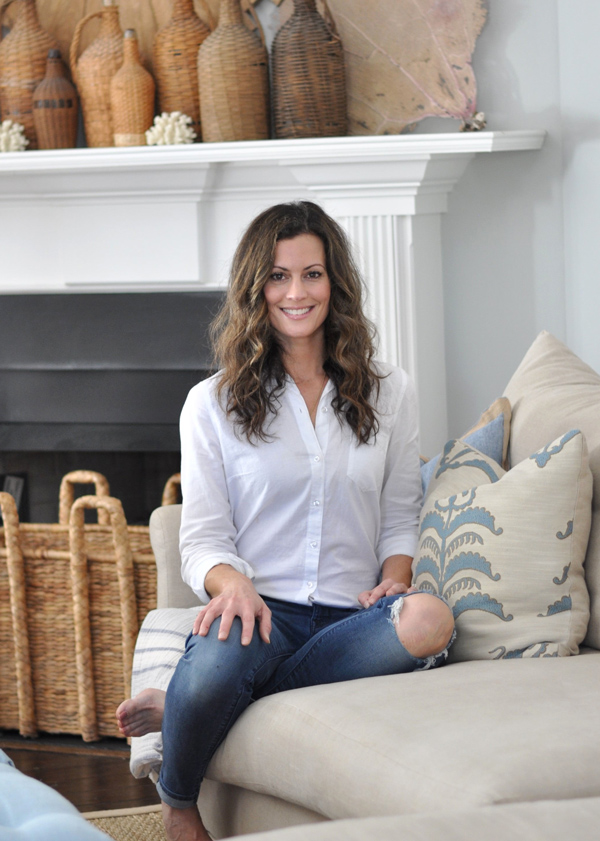diy: weathered wood paint treatment

After posting a few sneak peeks of some Queen Anne-style dining chairs I was working on a few weeks ago, I got a TON of emails asking about how I created the finish. Seriously, you guys are the best with all your sweet comments and emails and even though I was originally waiting to reupholster the seats to do a complete before and after, I thought I’d give step-by-step instructions here on how to get the look, instead of holding out on you for another couple of weeks!
These chairs have seen every paint color in the rainbow, so when I decided I wanted a soft, weathered gray stained finish, I settled in for some major prep work. I ended up burning through what seemed like hundreds of sheets of sand paper and even stripped as much of it as I could with a nontoxic stripper only to discover that the front legs were made of different wood than the rest of the chair. This meant that it did not take the stain very well – it had a weird pinkish/green undertone and it was UGLY. After all that prep work, I decided to try my hand at creating a similar look with paint without making it look like I was trying to create a wood look with paint, if you know what I mean. While this isn’t necessarily too difficult, it’s an extremely time consuming project, but the result is so, SO worth it!

1. Prime. I swear by this all-purpose primer from Sherwin Williams. It works just as beautifully on metal and plastic as it does on wood and is great for smaller projects that don’t necessarily require a lot of sanding. You can just prime right over it. I put a light, even coat on first and waited for it to dry completely.
2. Paint. I applied two even coats of a warm, woody color (Pratt and Lambert’s Creme Liqueur). Wait for each coat to dry completely before applying the next.
3. Whitewash. Whitewashing tones down the wood colored paint dramatically and adds softness. There really is no magic formula for this, but I’ve found that 2 parts glaze mixed with 1 part white latex paint and a little bit of water to thin it out works best for me. Brush the mixture onto your piece and then wipe it back with a clean, white cloth. The more water or glaze you add to the mix gives you more working time, so if you’re a beginner, you won’t be frazzled or find that the mixture starts to dry before you can wipe it back again. I posted step-by-step instructions a while back on whitewashing; check it out here. Any glaze will work, but I’ve always had success with this one.
4. Dry brush. Once the whitewashing is dry, I used a dry, angled paint brush to dry brush white paint on top. Lighting dip the brush into white paint and then blot it on a paper towel or drop cloth until there is almost no paint on the brush. Then, softly brush the paint onto your piece of furniture. If you’re doing a large surface area like a table top, use long, soft strokes to avoid a stripey effect. Remember to flick the brush back and forth over corners, legs, or any raised surface to really highlight and enhance detail areas. I showed how to do this in this article, as well. If you mess up, don’t fret….you can always paint over it then whitewash and dry brush again. (if you want to see more pictures of how I did this step, check out my post here.)
5. Stain. Once you’re happy with how your whitewashing and dry brushing turned out, it’s time to stain! I used a foam brush to brush on walnut stain, working in small sections across the entire chair and then wiping it back off with a clean cloth. (I buy packs of tee shirt rags from Lowe’s on the regular). You have to work a little quicker on this step as the stain will dry darker if you don’t wipe it back within a minute or two (max) of brushing it on. Stain adds depth and softness, really making the piece look finished.
Don’t forget that imperfection is really perfection with this particular finish-it all adds to the charm and character! I really love how these turned out:





Posted in DIY, paint technique

Hello and welcome to Bungalow Blue Interiors!
I'm Kelly, interior designer, stylist, hostess with the mostest and editor of my blog, where I share pics of my work, my own home, décor projects, entertaining hacks, where to find the best decorating deals and all the beautiful things that are currently inspiring me!

Wow, I'm really impressed! Would love to try this!
Thanks, Kate! If I remember correctly, you score a set of similar chairs?
I did! The finish on them is good but not perfect. They are likely from the 40s or 50s if I remember right. I would loooooove to do this to them, but the table is stained a similar color to the chairs. And my husband spent ages refinishing the table, so there's no way I would redo the table too. We're about to turn our screened in porch into a sunroom with a spot for an "eat in kitchen" (obviously not in the kitchen, but as close as we'll get). I'm wondering if I can find a set and refinish using your technique. Hard to find a new set that's not $$$$ that doesn't have a fake looking wood finish on it. We'll see!
Hello. Your piece looks like it has a satin finish to it. Did you use a regular stain (vs one with a poly added)? Did you add a top protective coat to finish it? Wax maybe? I will be doing this to a pedestal dining table. The look you achieved is beautiful!
Cheryl
Hi Cheryl – Thank you so much! I just used a regular walnut stain and then wiped it back and let it dry completely. I actually didn't use a top coat on these chairs and they've held up very well but if you want a protective layer, I would suggest using a wipe on poly in a matte, flat or satin finish OR you could use a wax. Best of luck with your table! xx